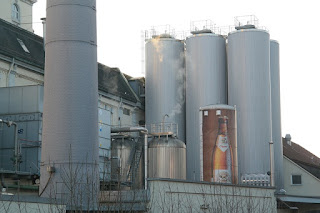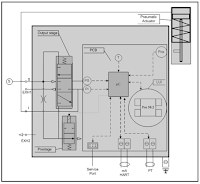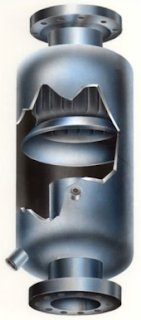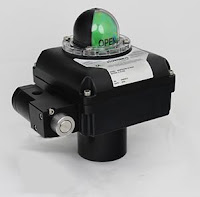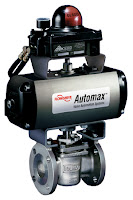What are Vacuum Breakers and why do we need them?
Vacuum breakers are spring-loaded valve and seat devices that are mounted on or near the steam space of a heat exchanger allowing steam pressurization of the space, but during throttling down or shut off of steam supply also allow the valve to overcome the spring force and open when vacuum is present. The vacuum is formed when steam, with its much higher specific volume than water, condenses to water with heat exchange and is not replaced in the heat exchange space with an equivalent volume of steam, i.e. when the control valve is throttling down from its process design maximum flow, or when steam is being shut off after completion of the process step. By “breaking” the sub-atmospheric condition which occurs in those situations by allowing air into what was the steam space through the open vacuum breaker device; condensate drainage from the heat exchanger by gravity is enabled. This prevents water hammer, internal corrosion, gasket or joint leakage, and potential damage to the heat exchanger and other equipment. Without this device, a reverse pressure differential is formed in the steam space due to vacuum which will suck available condensate from the return system into the calandria, coil, or other large cavity heat exchanger.
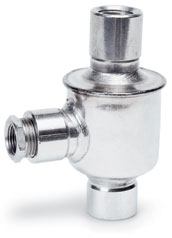 |
| Stainless Steel Thermostatic Air Vent/Vacuum Breaker (TAVB) |
What are Thermostatic Air Vents and why do we need them?
Thermostatic air vents (TAV) are also valve and seat devices that are actuated by temperature, typically a “balanced” bellows. The bellows has an alcohol and water charge inside that evaporates and expands on temperature increase approaching the steam saturation curve for the particular steam pressure. The expanding bellows drives the valve into the seat and closes the device. On steam start-up of the heat exchanger, cool air is expelled quickly by using this device until steam reaches it which quickly closes the valve. Similarly, on decreasing temperature, at some point a few degrees lower than the steam saturation curve, the mixture in the bellows condenses and contracts the bellows which pulls the valve plug away from the seat and thus opens the vent. This signifies that non-condensable gases have accumulated and the temperature has depressed enough to allow the valve to open and expel them from the steam space. Pressure is inconsequential up to the TAV design pressure since the alcohol charge is designed to follow the steam saturation curve, offset but parallel, always activating a few degrees below saturation temperature for any given pressure (including vacuum).
Doesn’t the Steam Trap do this as one of its functions?
It is true that one of the three primary functions of the steam trap is to remove non-condensable gases. By virtue of the modularization of steam supply and condensate removal equipment at some distance away from the internal heat exchangers of kettles and cookers for example due to floor space restrictions in the brew house, size, configuration, and internal area of heat transfer equipment in modern breweries and the demands of production, it is imperative that these supplemental devices be used to remove these gases as close and as quickly as possible to the area where they would be entrapped: opposite the steam supply connection of the exchanger.
Why is it so important that air be removed?
There are several reasons, but most importantly, air is an excellent insulator and, without removal, serves to insulate internal heat transfer surfaces from the steam trying to transfer its latent heat. Surface temperature drops of 20-30% are not uncommon with systems unable to effectively remove non-condensable gases. From a secondary standpoint, air and other gases create internal oxidation and corrosion that corrode the system from the inside out. As we already know, a major source of air in the system comes from the vacuum breakers which contribute to piping oxidation if the air is not removed. CO2 entrained in steam turn condensate into carbonic acid (H2CO3) when turned into solution if not removed.
These two devices, TAVs and VBs, are frequently confused as to their function. Remember that TAVs primarily expel non-condensable gases and air on startup; and VBs primarily allow air in on shutdown. Their mounting is critical to their successful operation. Observe the following rules for mounting:
- As close to the exchanger as possible on a line with a vertical accumulator, if not on the exchanger itself, opposite the steam supply.
- Condensate line must be large enough to allow disengagement if horizontal or a vertical accumulator will be needed. If not, the TAV will discharge condensate which means it is not discharging air. The vacuum breaker will spit and leak over time as well.
- The vertical accumulator is used to provide an accumulation area for non-condensables. It is typically 2” or larger pipe, approximately 2 ft. high if space allows. An isolation valve should be used between the accumulator and the TAV to isolate for maintenance or system air testing. Note that these devices should be excluded from any air test boundaries since the bellows is “balanced,” meaning that steam pressure has a corresponding saturation temperature to “balance” internal pressure of the bellows against external pressure caused by the steam pressure. Air would not allow this balance to take place and would either not close the valve on the air test, or would rupture the bellows if the isolation valve were downstream.
Article written by Steve Huffman, Mead O'Brien, Inc.
